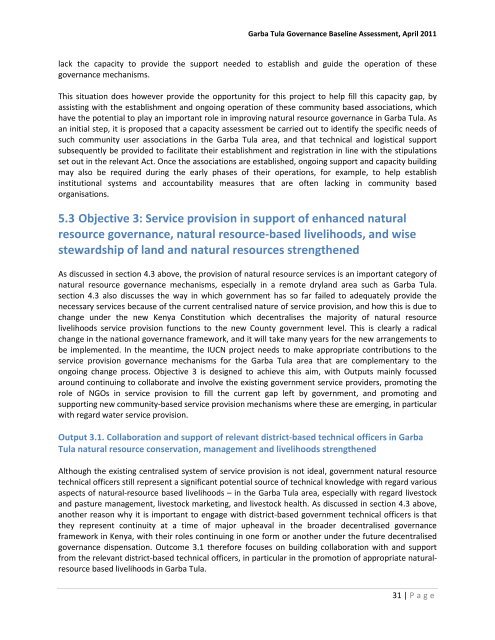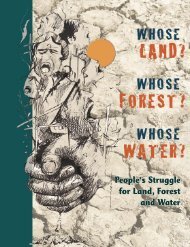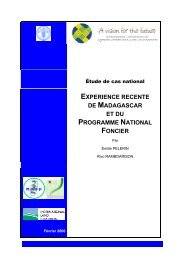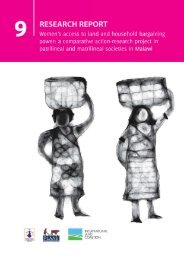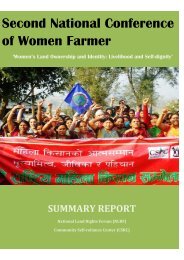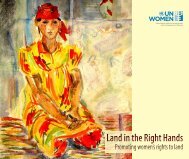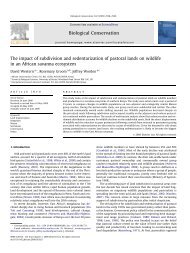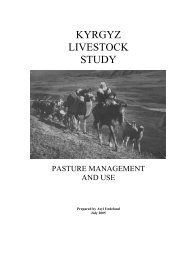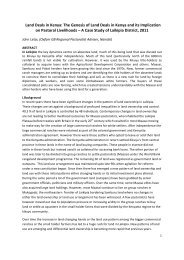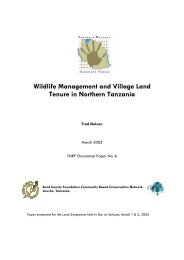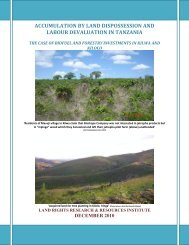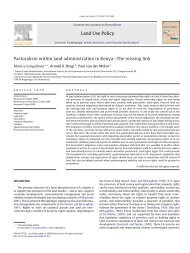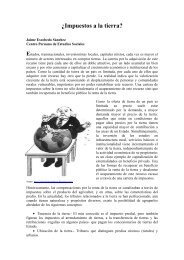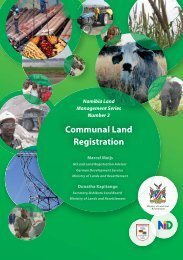Garba Tula Governance Assessment Final Report ... - Land Portal
Garba Tula Governance Assessment Final Report ... - Land Portal
Garba Tula Governance Assessment Final Report ... - Land Portal
Create successful ePaper yourself
Turn your PDF publications into a flip-book with our unique Google optimized e-Paper software.
<strong>Garba</strong> <strong>Tula</strong> <strong>Governance</strong> Baseline <strong>Assessment</strong>, April 2011<br />
lack the capacity to provide the support needed to establish and guide the operation of these<br />
governance mechanisms.<br />
This situation does however provide the opportunity for this project to help fill this capacity gap, by<br />
assisting with the establishment and ongoing operation of these community based associations, which<br />
have the potential to play an important role in improving natural resource governance in <strong>Garba</strong> <strong>Tula</strong>. As<br />
an initial step, it is proposed that a capacity assessment be carried out to identify the specific needs of<br />
such community user associations in the <strong>Garba</strong> <strong>Tula</strong> area, and that technical and logistical support<br />
subsequently be provided to facilitate their establishment and registration in line with the stipulations<br />
set out in the relevant Act. Once the associations are established, ongoing support and capacity building<br />
may also be required during the early phases of their operations, for example, to help establish<br />
institutional systems and accountability measures that are often lacking in community based<br />
organisations.<br />
5.3 Objective 3: Service provision in support of enhanced natural<br />
resource governance, natural resource-based livelihoods, and wise<br />
stewardship of land and natural resources strengthened<br />
As discussed in section 4.3 above, the provision of natural resource services is an important category of<br />
natural resource governance mechanisms, especially in a remote dryland area such as <strong>Garba</strong> <strong>Tula</strong>.<br />
section 4.3 also discusses the way in which government has so far failed to adequately provide the<br />
necessary services because of the current centralised nature of service provision, and how this is due to<br />
change under the new Kenya Constitution which decentralises the majority of natural resource<br />
livelihoods service provision functions to the new County government level. This is clearly a radical<br />
change in the national governance framework, and it will take many years for the new arrangements to<br />
be implemented. In the meantime, the IUCN project needs to make appropriate contributions to the<br />
service provision governance mechanisms for the <strong>Garba</strong> <strong>Tula</strong> area that are complementary to the<br />
ongoing change process. Objective 3 is designed to achieve this aim, with Outputs mainly focussed<br />
around continuing to collaborate and involve the existing government service providers, promoting the<br />
role of NGOs in service provision to fill the current gap left by government, and promoting and<br />
supporting new community-based service provision mechanisms where these are emerging, in particular<br />
with regard water service provision.<br />
Output 3.1. Collaboration and support of relevant district-based technical officers in <strong>Garba</strong><br />
<strong>Tula</strong> natural resource conservation, management and livelihoods strengthened<br />
Although the existing centralised system of service provision is not ideal, government natural resource<br />
technical officers still represent a significant potential source of technical knowledge with regard various<br />
aspects of natural-resource based livelihoods – in the <strong>Garba</strong> <strong>Tula</strong> area, especially with regard livestock<br />
and pasture management, livestock marketing, and livestock health. As discussed in section 4.3 above,<br />
another reason why it is important to engage with district-based government technical officers is that<br />
they represent continuity at a time of major upheaval in the broader decentralised governance<br />
framework in Kenya, with their roles continuing in one form or another under the future decentralised<br />
governance dispensation. Outcome 3.1 therefore focuses on building collaboration with and support<br />
from the relevant district-based technical officers, in particular in the promotion of appropriate naturalresource<br />
based livelihoods in <strong>Garba</strong> <strong>Tula</strong>.<br />
31 | P a g e


